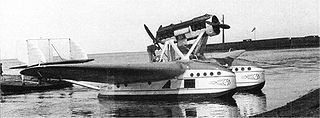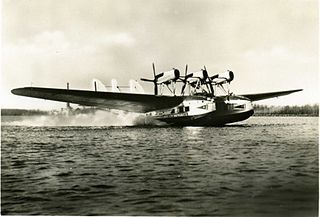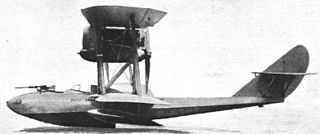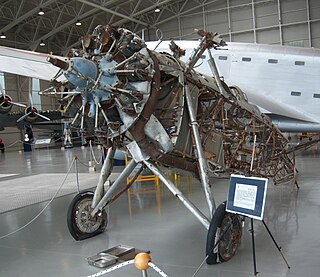
The Savoia-Marchetti S.55 was a double-hulled flying boat produced in Italy, beginning in 1924. Shortly after its introduction, it began setting records for speed, payload, altitude and range.

The Savoia-Marchetti SM.81 Pipistrello was the first three-engine bomber/transport aircraft serving in the Italian Regia Aeronautica. When it appeared in 1935, it represented a real step ahead in Italian military aviation: it was fast, well armed and had a long range. It proved effective during the war with Ethiopia and the Spanish Civil War. Despite being too slow to remain competitive as a bomber in the later years of World War II, it was one of the most flexible, reliable and important aircraft of the Regia Aeronautica from 1935 to 1944, and adapted to second-line duties in a wide range of tasks.

The Savoia-Marchetti SM.75 Marsupiale was an Italian passenger and military transport aircraft of the 1930s and 1940s. It was a low-wing, trimotor monoplane of mixed metal and wood construction with a retractable tailwheel undercarriage. It was the last of a line of transport aeroplanes that Alessandro Marchetti began designing in the early 1930s. The SM.75 was fast, robust, capable of long-range flight and could carry up to 24 passengers for 1,000 miles.

The Breda Ba.25 was an Italian two-seat biplane trainer designed and built by the Breda company. It was the most widely used Italian basic trainer of the 1930s.

The Fiat CR.1 was an Italian biplane fighter aircraft of the 1920s. Of wood-and-fabric construction, it was designed by Celestino Rosatelli, from whom it gained the 'CR' designation. Its most distinctive feature was that the lower wings were longer than the upper ones.

The Caproni Ca.100 was the standard trainer aircraft of the Regia Aeronautica in the 1930s. Large numbers of this tandem, two-seat, biplane were built, powered by different engines.

The Savoia-Marchetti SM.95 was an Italian four-engine, mid-range transport aircraft, which first flew in 1943. It was the successor of the Savoia-Marchetti SM.75.

The Savoia-Marchetti SM.78 was an Italian bomber/reconnaissance biplane flying boat of the early 1930s.

The Savoia-Marchetti SM.62 was an Italian single-engine maritime patrol flying boat produced from 1926. It served with the Regia Aeronautica and with a number of foreign users, and was licence-produced in Spain and the Soviet Union. Some of the Spanish aircraft were still in service during the Spanish Civil War

The Fiat G.12 was an Italian transport aircraft of World War II.

The Budd BB-1 Pioneer was an experimental United States flying boat of the 1930s utilizing the Savoia-Marchetti S.56 design. Its framework was constructed entirely of stainless steel, using a newly patented method of welding that alloy.

The Savoia-Marchetti S.59 was a 1920s Italian reconnaissance/bomber flying boat designed and built by Savoia-Marchetti for the Regia Aeronautica.

The Savoia-Marchetti S.66 was a 1930s Italian twin-hull flying boat designed and built by Savoia-Marchetti as an enlarged development of the S.55.

The Savoia-Marchetti S.57 was an Italian single-engine biplane flying boat intended for aerial reconnaissance, built by Savoia-Marchetti for Regia Aeronautica after World War I.

The Savoia-Marchetti S.72 was an Italian three-engine transport monoplane designed and built by Savoia-Marchetti as an enlarged and strengthened version of the earlier S.71. The S.72 was a three-engine, high-wing cantilever monoplane with a fixed tailwheel landing gear. Designed as a heavy bomber, the prototype was first flown in 1934 powered by three 410 kW (550 hp) Alfa Romeo licence-built Bristol Pegasus radial engines.

The SIAI S.52 was an Italian fighter prototype of 1924.

The SIAI S.58 or Savoia-Marchetti S.M.58 was an Italian flying boat fighter prototype of the 1920s designed and manufactured by SIAI.

The Savoia-Marchetti SM.80 was a two-seat monoplane amphibian tourer, with a single, tractor engine mounted above the wing, designed in Italy in the early 1930s. The SM.80bis was a four-seat variant, powered by two pusher engines.
The Piaggio P.XIX was an Italian aircraft engine produced by Rinaldo Piaggio S.p.A. during World War II and used to power aircraft of the Regia Aeronautica.

The Piaggio P.IX, or Piaggio Stella P.IX, was an Italian nine-cylinder radial aircraft engine produced by Rinaldo Piaggio S.p.A. Based on the Gnome-Rhône 9K, the engine was rated at 600 hp (447 kW). Production was used to power a number of other aircraft developed in Italy. The main users were the Savoia-Marchetti SM.81 transport and the IMAM Ro.37bis, the main reconnaissance aircraft in the Regia Aeronautica during the Second Italo-Ethiopian War, Spanish Civil War and Second World War, but the engine was also used by other designs, including the prototype Savoia-Marchetti SM.79.























